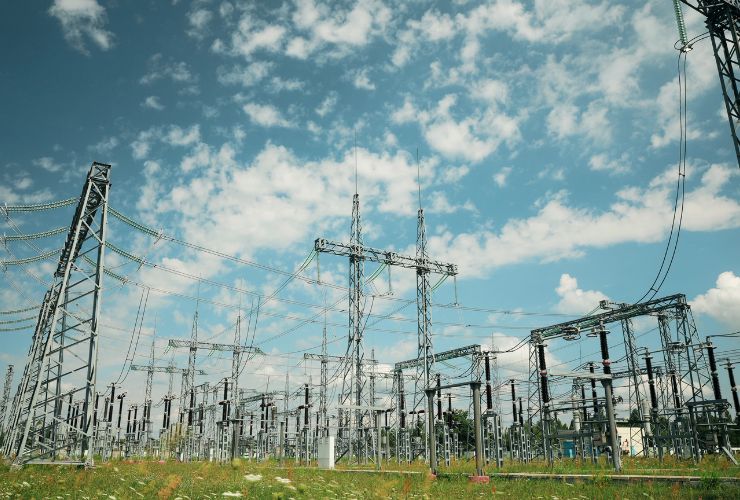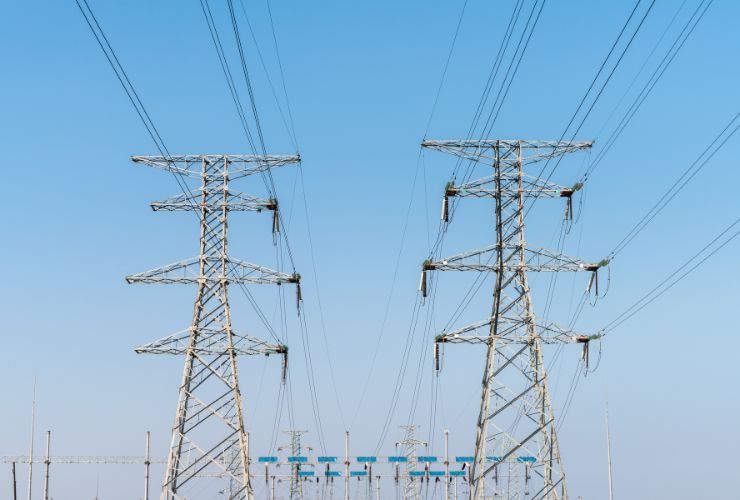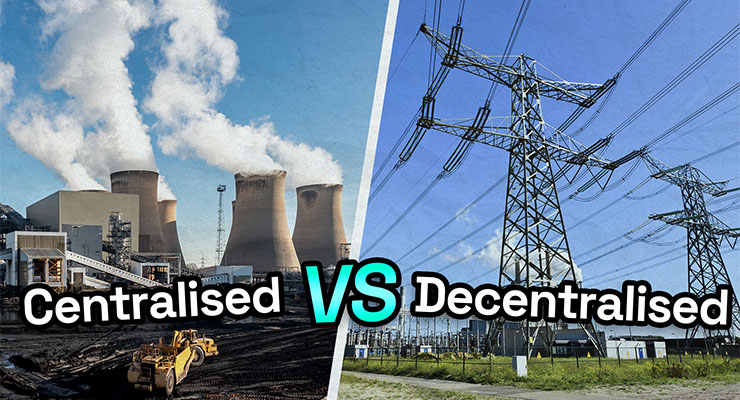Fast read
Both centralised and decentralised power grids have pros and cons. Centralised grids are efficient, thanks to economies of scale, and ensure a stable, long-distance power supply. However, they often rely on fossil fuels, lack user control, and entail high initial costs.
Decentralised grids offer localised power, energy independence for communities, and reduced transmission losses. Yet they require large upfront investments and may struggle with scalability. The choice between the two depends on various factors like technology, energy demand, and environmental concerns.
As renewable energy technologies like solar and wind become more viable, the trend is shifting towards decentralised grids, particularly in Australia. If you are considering using solar or other renewable energy sources, it is recommended to consult with a local expert. The expert can provide guidance and assistance in determining the best options for your specific needs.
They can also help you navigate the process of implementing renewable energy solutions. Consulting with a local expert can ensure that you make informed decisions and maximise the benefits of using renewable energy sources.
What are the differences between a centralised vs a decentralised energy grid?
The electricity grid has traditionally been built and operated on a centralised model in Australia and most of the world. This is where a few large centralised power stations produce electricity and then distribute it over long transmission distances to supply homes and businesses nationwide. The power stations that have dominated the electrical supply landscape since early in the 20th century were based on being located close to the coal mines.
Given the technology available and options, it was the most cost-effective way to produce electricity close to the fuel source. Minimising the cost of transporting and supplying coal to the power stations. The cost savings with this centralised generation outweighed the costs and energy losses from transmitting the electricity long distances.
Changing technology, particularly solar panel generation and storage, is quickly changing the landscape and value towards a decentralised electricity grid. This sees many smaller generators across the grid supplying and meeting electricity requirements. Residential solar systems dominate this model in Australia, where electricity is first consumed onsite. The country is also seeing an increasing number of solar and wind farms.
Centralised Energy Grid
What are the advantages?
Efficiency
Big power plants are really good at making lots of energy, and they’re often cheaper than smaller ones when you look at how much energy they produce. This is because they benefit from something called economies of scale, which means the bigger they are, the less it costs to make each unit of electricity.
Centralised power grids, which rely on these large-scale power plants, receive these cost benefits. They can produce electricity more efficiently and at a lower cost. Plus, they can use resources like fuel and infrastructure more effectively.
For example, a large-scale power plant can burn fuel more efficiently than numerous small ones, such as solar panels or wind turbines. Also, fewer transmission lines are needed to carry electricity from big plants, compared to many small ones spread out over a wide area.
Grid infrastructure
In big power grids, like the ones with centralised power plants, there are things called substations, transformers, and high-voltage transmission of power lines. These are all part of the system that moves electricity from where it’s made to where it’s used.
Substations are places where electricity gets changed from really high voltage to lower voltage so it’s safer to use in homes and businesses. Transformers help with this by changing the electricity’s voltage. And high-voltage transmission lines are like super-highways that carry electricity over long distances, even between different places.
Stability
Centralised grids are built to deliver a steady and dependable electricity supply. They have backup systems and redundancy procedures to guarantee continuous power distribution to customers. Load balancing and centralisation can effectively manage electricity generation and distribution.

What about the disadvantages?
Environmental Issues
Fossil fuels like coal and natural gas, which increase greenhouse gas emissions and air pollution, are frequently used in centralised systems. These emissions harm human health and significantly contribute to climate change.
Decreased control
In a centralised power system, customers can’t decide how their electricity is made. They have to rely on utility companies to give them electricity, so they don’t get to choose where their energy comes from or how it’s produced. This means customers have minimal control over their energy sources.
Expensive
Constructing and maintaining large-scale power plants and all associated infrastructure can be extremely costly. These costs often get passed on to customers through their electricity bills, which can make electricity more expensive for everyone.
Decentralised Grid
A decentralised power grid is also called a distributed energy system. It distributes power generation among many small-scale, local sources. It does not rely on a single large centralised power plant. This setup is gaining popularity because it offers several benefits.
Firstly, a decentralised grid is more resilient. If one source of power fails, the others can still keep things running smoothly. This makes the whole system more reliable and less prone to outages.
Secondly, it’s more flexible. With lots of smaller sources of power, it’s easier to adjust to changes in demand and supply. This means we can better match how much power is being generated with how much is needed, reducing waste and saving money.
Additionally, a decentralised grid is often more environmentally friendly. It promotes using solar panels and wind turbines to create clean energy and decrease our dependence on fossil fuels.
The Advantages
Power Production
In a decentralised grid, energy is produced from various small-scale or renewable sources, such as solar cells, wind turbines, micro-hydro systems, and biomass generators. In a centralised grid, energy is primarily produced at large-scale power plants.
Local Power
Local communities have the chance to become self-sufficient in terms of energy production and consumption thanks to decentralised networks. Self-generation by people, communities, or organisations encourages energy independence and regional economic growth.
Efficiency
In decentralised grids, electricity is produced closer to where it’s used, which can make them work better. When electricity doesn’t have to travel as far, it doesn’t lose as much energy along the way. This means less energy is wasted, making the grid more efficient overall.

The Disadvantages
Costs
For constructing distributed power sources, like solar or wind turbines. Establishing a decentralised grid requires large upfront investments.
Scalability issues
Scalability can be a challenge for decentralised grids. Although they work well for small and medium-sized needs, providing reliable electricity to large cities or industrial areas might require some adjustments.
In these cases, it’s often necessary to combine decentralised grids with a centralised one or to plan carefully. This way, we can make sure that the power supply meets the demands of bigger communities without any issues.
We can ensure that everyone has reliable access to electricity by finding a balance between decentralised and centralised approaches. This means that no matter where someone is located, they will have access to electricity.
Decentralised approaches involve smaller, local systems for generating electricity. Centralised approaches involve larger, regional systems. By combining these two approaches, we can create a reliable and widespread electricity network for everyone.
In Summary
In summary, both centralised and decentralised power grids have their pros and cons. The choice between them depends on factors like technology, energy needs, location, and environmental concerns.
Centralised grids have been the go-to option for big-scale power generation because they’re efficient, cost-effective, and ensure a steady power supply. However, they’re often linked to environmental issues due to reliance on fossil fuels and high infrastructure costs.
Decentralised grids have benefits. They produce power locally.
This reduces energy loss during transmission. They also use a wider range of renewable energy sources. They also help communities become more self-sufficient with their energy needs.



